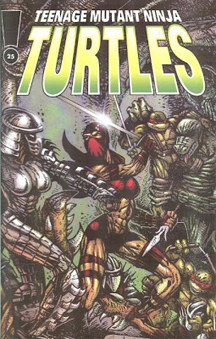The cops in the 1990 “TMNT” movie found their answers at the east warehouse over at Lairdman Island, and fans of the “TMNT” comics finally got their answers to the Volume 3 cliffhangers in the independently produced Issues 24 (2011) and 25 (2012), which can be downloaded here.
Not only are these good comics considering that they originated from outside the Mirage and Image offices, but frankly, they are among the best “TMNT” comics even without that qualifier.
Linking volumes 3 and 4
While a reader could choose to accept Peter Laird’s contention that Volume 3 doesn’t count (he didn’t incorporate the Volume 3 events into his Volume 4 narrative, nor does “Tales” Volume 2 dip into the Volume 3 era), it’s much more satisfying for a fan to imagine that it does count.

“Teenage Mutant Ninja Turtles” Vol. 3 Issues 24-25 (2011-12)
Writer: Andrew Modeen
Pencils: Arsniy Dubakov
Inks: Arsniy Dubakov
The brilliance of writer Andrew Modeen and penciler/inker Arsniy Dubakov’s Issues 24-25 is twofold: First, they incorporate the events from all Mirage/Image comics and use brilliant plotting to fill in the gap between Volumes 3 and 4. Second, it’s just a damn good story.
And fans can feel extra good because this project had the blessing (and even contributions of splash pages and pinups) from many Mirage and Image veterans (all the way up to Kevin Eastman, who inks the cover of Issue 25). Most notably, it incorporates story notes from Gary Carlson.
Thus, 12 years later, we learned that Lady Shredder is Tang Amaya, the sister of Tang Shen and the mother (along with Oroku Saki) of Pimiko. (“Hey, I’ve seen this movie,” Mike quips in a line that could’ve been Carlson’s.)
We also find out, via her backstory in Issue 24, that Lady Shredder crossed paths with the Turtles under various aliases through the years, notably as Headhunter in “Big Bang Comics” 10. This was a perfect twist: The Lady Shredder’s identity wasn’t obvious (Karai was the only strong candidate among established characters; Raph even guesses that Lady Shredder is Karai in Issue 25), yet it ties intimately with the ongoing Clan Hamato vs. Clan Oroku feud.
Also, Leo’s hand regenerates (something Carlson had planned), and Modeen incorporates the Baxter robot from Volume 2 as a catalyst for Don’s story of regeneration. Voila! The Turtles are physically back to normal and ready for Volume 4, and it feels natural – unavoidably rushed storytelling, perhaps, but not a cheat.
Rivalries and relationships
While Issue 24 is so short on fight scenes that one might assume fights are not in Dubakov’s wheelhouse, Issue 25 is visually outstanding as the Turtles and Foot Clan have a massive brawl in the sewers, with the mother-daughter clash at the center of it all.
Assisted by tones by David Seltzer and Red Herring Color that call to mind the duo-tones of early Mirage books, the Image saga comes to a suitably epic, emotional conclusion, with Raph even admitting to Leo that he had a thing for Pimiko as they burn her body on a floating pyre that calls to mind the end of Volume 1, Issue 21.
Also on the relationship front, Leo tells Raph he had been secretly dating Radical (something we’ll learn about, if you’re following these stories chronologically, in the 2000s Mirage comics), and the flighty Sara (now dating the Savage Dragon) leaves Mike heartbroken – and bereft of his love of writing, which he doesn’t continue in Volume 4.
While Raph’s thing for Pimiko didn’t have time to develop, and I haven’t read the Leo-Radical stuff yet, I love his bonding moment with Leo. And Mike’s shock at Sara’s rejection is a gorgeous encapsulation of first love and first loss.
Satisfying revelations
Sure, a lot of Issue 25 is an info-dump, as Leatherhead comes back to Earth in order to send Dr. X back to the Utrom world, where the Utroms decide Earth is ready for Utrom takeover; Leo dispatches his nemesis King Komodo; the Puzorelli crime family – a thorn in Casey and April’s side – is wiped out by the Foot; and the mysteriously absent Karai returns to Foot leadership, noting that she had been waiting for warring factions to wipe themselves out.
But all of these revelations are satisfying, like snapping those final pieces into a 5,000-piece jigsaw puzzle. Sure, in a perfect world, Carlson would’ve explored these threads himself at the turn of the century, perhaps handing them over a few years later to a re-invigorated Laird, who would’ve continued with his own vision without contradicting Carlson’s.
But since that did not happen, this is the next best thing, and to criticize it on any level would be absurd. Issues 24 and 25 are truly a gift to fans.
Bonus material
Oh, and that’s not all: There is also bonus material in the back of each issue. In Issue 24, the highlight is a Michaelangelo vignette from Will Tupper (who was known for short character pieces in “Tales” Volume 2); he also delivers a Raph-Casey tale, and we see Frank Fosco’s tryout art for the Image job showing the TMNT versus Spawn.
In Issue 25’s “Christmas Past,” Modeen has an older Shadow (from the Volume 4 era) remembering back to her upbringing with her Uncle Turtles in Volume 3. Also refreshing are a couple of pinups from Volume 2 writer/artist Jim Lawson – Cyborg Donatello and Lady Shredder vs. Pimiko – that demonstrate his love of the ongoing “TMNT” narrative goes beyond his own work. All of these backup strips and pinups further sew together Volumes 3 and 4.
The only thing missing is Laird stepping up and saying “You know, this is a cool project, and on second thought, Volume 3 and these bridge stories do count as Mirage TMNT canon,” and perhaps publishing them. (According to the Mirage website, Mirage can legally publish 12 “TMNT” comics per year as part of its agreement with Viacom.)
On the other, Laird hasn’t been antagonistic toward the project, and the “TMNT” comics narrative has always had an element where fans get to decide for themselves what “counts” and what doesn’t. In my mind, Issues 24 and 25 count for a lot.


